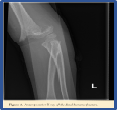Anterior interosseous nerve syndrome following paediatric supracondylar humeral fracture : a case report
Sindorm anteriornega intraosalnega živca pri otroškem suprakondilarnem prelomu nadlaktnice - prikaz primera
DOI:
https://doi.org/10.18690/actabiomed.205Ključne besede:
poškodba živca, otrok, prelom distalne nadlaktnice, zaplet, zdravljenjePovzetek
Namen: Anteriorni interosalni živec (AIŽ) je motorična veja medianega živca in poteka globoko v podlakti. Oživčuje tri mišice podlakti. Izolirana pareza je znana kot AIŽ sindrom. Pri otrokih so zlomi distalnega dela nadlaktnice pogosti prelomi, pri katerih so prav tako pogosto pridruženi nevrovaskularni zapleti. V članku prikazujem v naši vsakdanji praksi sorazmerno redek zaplet suoprakondilarnega preloma z razvojem AIŽ sindroma. Poročilo o primeru: Petletni fant je padel z gugalnice in si zlomil nadlaktnico. Šlo je za suprakondilarni prelom. Nevrološki izpadi niso bili opisani. Narejeni sta bili repozicija in učvrstitev s K žicami. Med kontrolami je mati opozorila, da bolnik ne more pokrčiti palca na operirani roki. Prepoznali smo AIŽ sindrom. Zaključek: Najverjetneje je bil sindrom AIŽ posledica poškodbe komolca samega. Zavoljo osredotočenosti na pogostejše nevrološke izpade, predvsem ulnarnega živca, smo razvoj AIŽ zaznali sorazmerno pozno.
Prenosi
Objavljeno
25.11.2021
Številka
Rubrika
Poročilo o primeru
Licenca
Avtorske pravice (c) 2020 Acta Medico-Biotechnica

To delo je licencirano pod Creative Commons Priznanje avtorstva 4.0 mednarodno licenco.
Kako citirati
Pevec, T. ., Kalšek, S. ., & Majerič, M. . (2021). Anterior interosseous nerve syndrome following paediatric supracondylar humeral fracture : a case report: Sindorm anteriornega intraosalnega živca pri otroškem suprakondilarnem prelomu nadlaktnice - prikaz primera. Acta Medico-Biotechnica, 13(2), 55-59. https://doi.org/10.18690/actabiomed.205